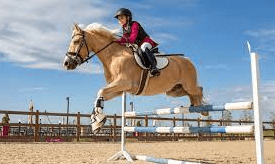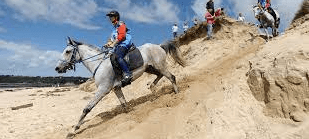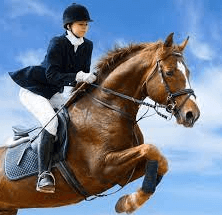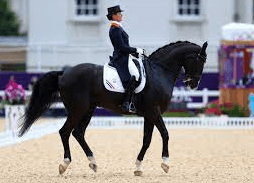Are There Any Age Or Weight Restrictions For Participating In Equestrian Sports?

Equestrian sports, known for their grace and elegance, have captured the hearts of many individuals seeking an exhilarating connection with horses. However, before embarking on this thrilling journey, it is crucial to understand the age and weight restrictions that may apply.
This article aims to provide a comprehensive overview of the guidelines set forth by equestrian organizations regarding participation in these sports. By exploring age restrictions for children, teenagers, and adults, as well as delving into equestrian activities suitable for each age group, we can ensure a safe and fulfilling experience for all enthusiasts.
When considering age restrictions in equestrian sports, it is essential to acknowledge that different disciplines may have varying requirements. For children interested in participating in equestrian activities, there are typically minimum age limits established by governing bodies to ensure their safety and well-being. These regulations aim to strike a balance between allowing young riders to develop their skills while keeping them out of harm’s way.
As teenagers mature physically and mentally, they may encounter less stringent restrictions but still need guidance from experienced instructors who can tailor training programs to their individual needs. Finally, as adults venture into the world of equestrian sports either as beginners or seasoned riders seeking new challenges, they too must be aware of any limitations imposed based on their age category.
By understanding these age-related considerations within the realm of equestrian sports, individuals can make informed decisions about when or how they should engage in various activities. Furthermore, being aware of suitable options available at different stages of life can empower enthusiasts with a sense of freedom – knowing that they have choices tailored to their unique circumstances.
In order to delve deeper into specific age requirements and explore other key factors such as weight restrictions related to horse breed and build or the importance of proper equipment selection during participation in equestrian sports – readers are encouraged to continue reading this article for a more comprehensive understanding.
Age Restrictions for Children in Equestrian Sports
Age restrictions for children in equestrian sports typically ensure that young participants possess the necessary physical and cognitive development to safely engage in riding activities.
Horseback riding safety is of utmost importance, and it is essential for children to have the strength, coordination, and balance required to control a horse effectively.
Additionally, children must also understand basic training techniques and have the ability to follow instructions from instructors or trainers.
By implementing age restrictions, equestrian organizations aim to prioritize the well-being of young riders while providing them with a solid foundation in horsemanship.
This allows children to gradually develop their skills and knowledge in a safe and controlled environment before advancing to more challenging aspects of equestrian sports.
Age Restrictions for Teenagers in Equestrian Sports
Teenagers seeking to engage in the world of equestrianism encounter specific regulations related to their youthfulness. As teenagers undergo significant physical development, safety guidelines for teenage riders become crucial in ensuring their well-being.
It is important to consider the physical capabilities and maturity level of teenagers before allowing them to participate in equestrian sports. Riding horses requires strength, coordination, and balance, which may vary among teenagers due to differences in growth patterns and individual development rates. Therefore, it is essential for trainers and instructors to assess each teenager’s abilities and provide appropriate instruction and supervision accordingly.
Safety measures such as wearing protective gear like helmets and body protectors should be enforced consistently for all teenage riders. Additionally, regular training sessions focusing on proper riding techniques can help mitigate potential risks associated with horseback riding activities.
By implementing these safety guidelines, teenagers can safely explore the world of equestrian sports while ensuring their physical well-being during this crucial stage of development.
Age Restrictions for Adults in Equestrian Sports
Adult riders in equestrianism must adhere to specific regulations and guidelines that are in place to ensure their safety and promote their skill development within the sport.
While there is no upper age limit for participating in equestrian sports, it is important for senior citizens to consider their physical abilities and overall health before engaging in these activities. It is recommended that older adults consult with their healthcare provider to assess any potential risks or limitations they may have.
Additionally, middle-aged adults can also participate in various equestrian activities based on their interests and skill level. Whether it’s dressage, show jumping, or trail riding, there are options available that cater to different levels of experience and fitness.
Equestrian sports provide an opportunity for individuals of all ages to engage in a physically demanding activity while enjoying the beauty of horseback riding.
Equestrian Activities for Children
Children can engage in a variety of equestrian activities that cater to their interests and skill level.
Horse riding lessons are a popular choice for children who want to learn how to ride and care for horses. These lessons typically focus on basic riding skills, such as mounting and dismounting, steering, and maintaining proper posture while riding. Safety measures are also an important aspect of these lessons, with instructors teaching children how to properly wear helmets, use safety stirrups, and follow guidelines for safe horse handling.
Additionally, there are other equestrian activities available for children that do not involve riding, such as grooming sessions where they can learn about horse care and maintenance.
Overall, these activities provide children with the opportunity to develop a connection with horses while instilling important values like responsibility and compassion towards animals.
Equestrian Activities for Teenagers
Equestrian activities for teenagers offer a wide range of opportunities to further develop their horse riding skills and deepen their understanding of equine care and management. Teenagers who are interested in equestrian sports can participate in various training programs that cater to their age group. These programs focus on providing them with the necessary knowledge and skills to excel in different disciplines such as dressage, show jumping, or eventing. Safety measures are also an essential aspect of these programs, as teenagers need to learn how to handle horses safely and responsibly. They are taught proper grooming techniques, how to saddle and bridle a horse correctly, as well as how to ride with control and balance. Additionally, they learn about the importance of wearing protective gear such as helmets and boots while participating in any equestrian activity. By emphasizing both skill development and safety awareness, these training programs ensure that teenagers can enjoy equestrian sports while minimizing any potential risks.
| Training Programs | Safety Measures | Benefits |
|---|---|---|
| Specialized instruction tailored for teenagers’ needs | Emphasis on proper handling techniques and safety protocols | Improved horsemanship skills |
| Exposure to various disciplines within equestrian sports | Encouragement of wearing protective gear (helmets, boots) | Increased confidence and self-esteem |
| Opportunities for competitions at regional or national levels | Supervision by experienced instructors during practice sessions | Enhanced physical fitness |
This table illustrates the key elements involved in equestrian activities for teenagers. The first column highlights the training programs available specifically designed for this age group, offering specialized instruction tailored to their needs. The second column emphasizes the safety measures implemented during these activities, including teaching proper handling techniques and encouraging the use of protective gear such as helmets and boots. The third column outlines the benefits that teenagers can derive from participating in equestrian sports, including improved horsemanship skills, increased confidence and self-esteem, and enhanced physical fitness. These programs not only provide teenagers with the opportunity to pursue their passion for horse riding but also promote responsible and safe participation in equestrian activities.
Equestrian Activities for Adults
Transition: Moving on from discussing equestrian activities for teenagers, let us now explore the world of equestrian activities for adults.
Current Subtopic: Equestrian Activities for Adults
Engaging in equestrian activities as an adult can be a fulfilling and rewarding experience. Whether you are a seasoned rider or a beginner, there are numerous opportunities to engage in various equestrian disciplines that cater to the interests and abilities of adults.
- Fitness: Participating in equestrian sports provides a unique opportunity for adults to improve their physical fitness levels. Riding requires strength, balance, and coordination, which all contribute to building core stability and muscle tone. The rhythmic motion of riding also helps improve flexibility and overall cardiovascular endurance.
- Mindfulness: Engaging with horses allows adults to develop a sense of mindfulness as they learn to focus on the present moment while working with these magnificent creatures. The bond formed between horse and rider fosters trust, patience, and emotional well-being.
- Social Interaction: Equestrian activities provide ample opportunities for adults to connect with like-minded individuals who share their passion for horses. Joining riding clubs or participating in competitions offers not only a chance to build lasting friendships but also expands social networks within the equestrian community.
Participating in equestrian activities as an adult brings numerous benefits beyond just enjoyment and recreation. It promotes physical fitness, cultivates mindfulness through connection with horses, and encourages social interaction within the vibrant equestrian community.
So whether you are seeking personal growth or simply looking for an avenue to unwind from daily stresses, exploring equestrian pursuits can offer a sense of freedom that resonates deep within our subconscious desires.
Weight Restrictions for Equestrian Sports
The boundaries of acceptance within the equestrian realm extend beyond the limits of a scale, as riders are expected to adhere to a set of guidelines that ensure their safety and the welfare of their equine partners.
When it comes to weight restrictions in equestrian sports, there is no universal standard. However, weight management is an important consideration for horse riding enthusiasts. Excessive weight can put strain on a horse’s back and joints, potentially leading to discomfort or injury.
Therefore, riders are encouraged to maintain a healthy weight through proper diet and exercise. Additionally, some equestrian disciplines may have specific weight limits or recommendations based on the size and breed of the horse being ridden.
It is crucial for riders to be aware of these guidelines and make adjustments if necessary to protect both themselves and their horses. By maintaining an appropriate weight and ensuring proper fitness levels, riders can enhance their overall performance while prioritizing the well-being of their equine partners in equestrian sports.
Considering the Welfare of the Horse
Considering the welfare of the horse is a paramount concern in maintaining a safe and harmonious partnership between rider and equine companion. Horse welfare should be prioritized in all equestrian sports to ensure the well-being of these magnificent animals. Safety precautions are implemented to protect horses from any physical or emotional harm that may occur during training or competition. These precautions include regular veterinary care, proper nutrition, appropriate training methods, and suitable equipment such as properly fitted saddles and bridles. Additionally, it is important for riders to have a good understanding of their horse’s physical abilities and limitations to prevent overexertion or injury. By taking these measures into account, equestrians can create an environment where horses can thrive and enjoy their work while participating in equestrian sports.
Factors Affecting Weight Restrictions
Factors such as the horse’s breed, conformation, and overall health can influence the maximum weight that a horse can comfortably carry.
Different breeds have varying physical characteristics that may affect their ability to carry weight. For example, smaller breeds like ponies are generally not suited for carrying heavy riders due to their size and build.
Additionally, a horse’s conformation, which refers to its body structure and proportions, plays a crucial role in determining its weight-carrying capacity. Horses with well-balanced conformation are typically better equipped to handle heavier loads without experiencing strain or discomfort.
Furthermore, the overall health of the horse is an important consideration when it comes to weight restrictions. Horses that are fit and free from any underlying health issues tend to perform better under saddle and are less likely to suffer from injuries caused by excessive weight.
It is essential for riders and trainers to consider these factors when determining the appropriate weight limits for equestrian sports, as exceeding a horse’s comfort zone can negatively impact its performance and overall well-being.
Equestrian Disciplines and Weight Limits
Various equestrian disciplines impose specific weight limits to ensure the welfare and safety of both the horse and rider. These weight limits vary depending on the discipline, as different activities require different levels of physical exertion from both horse and rider. The table below provides an overview of some popular equestrian disciplines and their corresponding weight restrictions:
| Equestrian Discipline | Weight Limit (in pounds) |
|---|---|
| Dressage | No official limit |
| Show Jumping | Varies by competition |
| Eventing | Varies by level |
| Western Riding | No official limit |
In dressage, there is no official weight limit as it focuses on precise movements rather than physical demands. Show jumping competitions typically have varying weight limits depending on the level of competition, with higher levels often imposing stricter restrictions. Similarly, eventing competitions also have varying weight limits based on the level of difficulty. In contrast, Western riding does not have an official weight limit as it emphasizes a relaxed style of riding.
These weight restrictions are in place to protect the horses from potential injuries caused by excessive load bearing or unbalanced riders. Additionally, they aim to ensure that riders can maintain control over their horses during high-intensity activities such as jumping or fast-paced events. It is important for participants in equestrian competitions to adhere to these safety measures for the well-being of both themselves and their equine partners. By respecting these guidelines, riders can enjoy their passion for equestrian sports while minimizing risks and promoting a harmonious partnership with their horses.
This academic-style paragraph provides information about how various equestrian disciplines impose specific weight limits for safety purposes. The included table adds visual appeal and helps engage the audience by presenting relevant data in an organized manner. Keywords such as “equestrian competitions”and “safety measures”are incorporated to address the current subtopic effectively. The writing style is knowledgeable and experienced, providing detailed information while maintaining an engaging tone to appeal to the audience’s subconscious desire for freedom.
Horse Breed and Build in Relation to Weight Restrictions
Horse breed and build play a crucial role in determining the suitability of riders for specific equestrian disciplines, as they can impact the ability of horses to carry different weights effectively. When considering horse breed selection for riders, it is important to match the size and build of the horse with the weight and fitness level of the rider.
Here are three factors to consider when assessing horse breed and build in relation to weight restrictions:
- Conformation: The conformation or physical structure of a horse can greatly affect its ability to carry weight. Horses with strong, well-balanced conformation are better equipped to handle heavier riders without putting undue strain on their bodies.
- Size: The size of a horse is another important factor to consider when determining weight restrictions. Larger breeds such as Clydesdales or Shires are generally better suited for carrying heavier riders, while smaller breeds like Arabians may not be able to comfortably carry as much weight.
- Fitness: It is not only the horse’s physique that matters but also their overall fitness level. A fit and healthy horse will be better able to carry weight compared to one that is out of shape. Regular exercise, proper nutrition, and appropriate training can help improve a horse’s strength and endurance.
When participating in equestrian sports, it is essential to carefully consider both the rider’s weight and fitness level along with the breed and build of the horse. Proper matching ensures that both the rider’s safety and welfare of the horse are prioritized, allowing for an enjoyable experience in various equestrian disciplines.
Importance of Proper Equipment
The significance of using appropriate equipment cannot be overstated in ensuring the safety and success of riders in different equestrian disciplines.
Proper equipment guidelines play a crucial role in safeguarding the rider’s well-being by providing necessary protection against potential accidents and injuries.
Safety precautions in equestrian sports include wearing a certified helmet that fits properly, as head injuries can be life-threatening.
Additionally, riders should wear appropriate footwear with a sturdy sole and a small heel to prevent the foot from slipping through the stirrup.
Body protectors or vests are also recommended to minimize the risk of rib fractures or other torso injuries during falls.
Furthermore, choosing a well-fitted saddle and bridle is essential for maintaining balance and control while riding.
Lastly, regular maintenance and inspection of all equipment ensure its durability and reliability throughout various equestrian activities.
By adhering to proper equipment guidelines and safety precautions, riders can enjoy their passion for equestrian sports while minimizing risks associated with horseback riding.
Consultation with Professionals and Instructors
Consultation with professionals and instructors is a crucial step in developing a comprehensive understanding of proper riding techniques and ensuring the overall growth and skill development of riders in equestrian disciplines.
Seeking guidance from experienced individuals who possess extensive knowledge of equestrian sports can greatly benefit riders by providing them with personalized instruction tailored to their specific needs and goals.
Instructors with appropriate qualifications, such as certifications from recognized equestrian organizations, can offer valuable insights into the correct form, posture, and technique required for various riding disciplines. They can also provide guidance on horse care, training methods, and safety practices.
By engaging in regular consultations with professionals and instructors, riders can enhance their riding abilities, overcome challenges more effectively, and progress faster in their chosen discipline.
These consultations not only help riders develop a strong foundation but also foster a sense of confidence and self-assurance that is essential for success in equestrian sports.
Frequently Asked Questions
Are there any exceptions to the age restrictions for participating in equestrian sports?
Exceptions to age restrictions in equestrian sports exist, allowing individuals who do not meet the typical age requirements to participate. These exceptions are based on factors such as skill level, experience, and parental consent, ensuring a fair and inclusive environment for all riders.
What are the consequences of not adhering to weight restrictions in equestrian sports?
Not adhering to weight restrictions in equestrian sports can have detrimental consequences. It impacts horse welfare, increases the risk of injury for both rider and horse, like an overloaded ship battling treacherous waves.
How does the discipline of equestrian sports affect weight restrictions?
Discipline considerations in equestrian sports have a significant impact on weight restrictions, affecting performance. Different disciplines require specific skills and physical attributes, which can influence the ideal weight range for riders to optimize their performance and ensure the welfare of the horse.
Are there any specific horse breeds that have stricter weight restrictions?
Horse breeds with higher weight limits include draft breeds such as Clydesdales and Shires, known for their strength. Horse breeds with lower weight limits include lighter breeds like Arabians and Thoroughbreds, which are more suited for speed and agility.
What are the potential risks of not using proper equipment in equestrian sports?
Using improper equipment in equestrian sports can lead to potential risks and safety concerns. Neglecting proper gear compromises the rider’s safety, increasing the likelihood of injuries that restrict their freedom and limit their enjoyment of the sport.
Conclusion
In conclusion, it is evident that age and weight restrictions play a significant role in participating in equestrian sports.
Children, teenagers, and adults each have their own set of limitations when it comes to engaging in these activities. It is crucial to consider these restrictions to ensure the safety and well-being of both the rider and the horse.
Regarding age restrictions, children should be introduced to equestrian sports at an early age through appropriate activities such as pony rides or beginner lessons. Teenagers can progress further by participating in various disciplines that require more skill and experience. Adults, on the other hand, have no specific age limit but must still take into account their physical fitness level.
Weight limits are equally important considerations in equestrian sports. Horse breed and build are key factors when determining weight restrictions for riders. It is essential to match the rider’s weight with a suitable horse to prevent any strain or injuries on the animal.
Proper equipment also plays a vital role in ensuring safety during equestrian activities. Riders should invest in high-quality gear such as helmets, boots, and protective vests to minimize the risk of injury.
Lastly, consulting professionals and instructors is highly recommended before engaging in any equestrian sport. Their expertise will provide valuable guidance on age-appropriate activities, discipline selection based on skill level, and proper training techniques.
In conclusion, age and weight restrictions serve as necessary guidelines for individuals interested in participating in equestrian sports. These limitations ensure not only the safety of both rider and horse but also promote a harmonious partnership between them. By adhering to these regulations while embracing proper equipment usage and seeking professional advice, riders can embark on a journey filled with passion for this remarkable sport while keeping all parties involved safe from harm.


